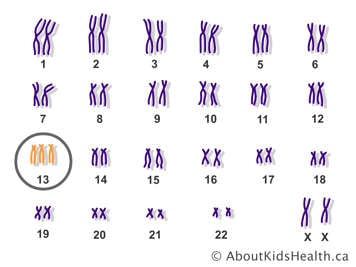What is a trisomy?
The term trisomy (say: TRY-so-mee) means that there are three chromosomes, rather than the usual pair of chromosomes. For example, a baby with Down syndrome usually has three copies of chromosome 21, rather than the usual pair. The condition is thus called “trisomy 21.”
What is trisomy 13?
Trisomy 13 is a rare chromosome abnormality that affects approximately one in every 8,000 to 12,000 live births. Babies with trisomy 13 have many abnormalities, involving nearly every organ system in the body, as well as developmental delay. Trisomy 13 is also called Patau syndrome, after the physician who first described the disorder.

Signs and symptoms of trisomy 13
Babies with trisomy 13 often have a normal birth weight, a small head and a sloping forehead. Noses are usually large (“bulbous”), ears are low-set and unusual in shape, eye defects occur frequently, and cleft lip and palate as well as heart defects are very common. Many babies with trisomy 13 are born with small areas of missing skin on the scalp (cutis aplasia), which resemble ulcers.
The brains in babies with trisomy 13 usually have major structural problems and often, the brain does not divide properly into two hemispheres, resulting in a condition called holoprosencephaly. Many babies with trisomy 13 have extra fingers and toes (polydactyly). Some present with a sac attached to the abdomen in the area of the umbilical cord (omphalocele), which contains some of the abdominal organs, as well as spina bifida. Girls may have an abnormally shaped uterus, called a bicornuate uterus. In boys, the testes sometimes fail to descend into the scrotum.
What causes trisomy 13?
Usually each egg and sperm cell contains 23 chromosomes. At the time of fertilization, the sperm and egg unite and create a cell with 23 chromosome pairs, or 46 chromosomes. In this manner, a child receives exactly half of their genetic material from each parent.
Sometimes, an error occurs when the egg or sperm cell is forming, causing it to have an extra chromosome. When this cell contributes the extra chromosome 13 to the embryo, trisomy 13 results. The extra chromosome 13 can come from either the mother’s egg cell or the father’s sperm cell. The abnormalities seen in babies with trisomy 13 result from having this extra chromosome 13 in each of the body’s cells. The incidence of this form of trisomy 13 is increased with maternal age.
Occasionally, the extra chromosome 13 is attached to another chromosome in the egg or sperm; this is called a translocation. This is the only form of trisomy 13 that can be inherited in a family. Sometimes, a parent can carry a “balanced” rearrangement where chromosome 13 is attached to another chromosome. However, since the parent does not have any extra or missing chromosome material, they are said to have a “balanced translocation” since they are normal and healthy.
Rarely, mosaic trisomy 13 may occur when the error in cell division occurs after fertilization. These babies have some cells with an extra chromosome 13 and others with the normal number. These cases usually have milder manifestations.
Diagnosis of trisomy 13
Babies with trisomy 13 have a unique group of characteristics and can be diagnosed by physical examination. To confirm the diagnosis, a small blood sample can be taken and the chromosomes can be analyzed to determine the presence of an extra chromosome 13.
Chromosomal abnormalities can also be diagnosed before birth by analyzing cells in the amniotic fluid obtained by amniocentesis, or from the placenta, obtained by chorionic villus sampling (CVS) or from the fetal blood obtained by cordocentesis. Screening for trisomy 13 is also available through first trimester screening (FTS), integrated prenatal screening (IPS) or by non-invasive prenatal testing (NIPT). The diagnosis of trisomy 13 can also be suggested by detailed fetal ultrasound; however, ultrasound is not 100% accurate, since not all abnormalities can be seen on ultrasound and the same abnormalities seen prenatally in trisomy 13 can also be seen in other conditions. In contrast, a chromosome analysis, whether performed on fetal/newborn blood sample, cells from the amniotic fluid or placental sample, is over 99.9% accurate.
Life expectancy of a baby with trisomy 13
Fifty per cent of babies born with trisomy 13 survive beyond their first 7.5 to 12.5 days. About 20% of babies born with trisomy 13 survive the first year of life. It is difficult to predict the life expectancy of a baby with trisomy 13 if the baby does not have any immediate life-threatening problems. For babies that have survived their first 30 days of life, 47% were alive at one year. About 13% of children born with trisomy 13 survive until 10 years of age.
There is a small chance of having another child with trisomy 13
The risk of having a baby with trisomy 13 increases slightly with the mother’s age. However, the average age of the mother at delivery of a baby with trisomy 13 is 32 years. In general, in each subsequent pregnancy, the chance of having another baby with trisomy 13 is no greater than 1%.
Genetic counselling is recommended
Parents of a baby with trisomy 13 are encouraged to seek genetic counselling. This can help parents to:
- understand the results of chromosomal tests in detail
- understand the chances that other babies will be affected
- understand the diagnosis options for future pregnancies